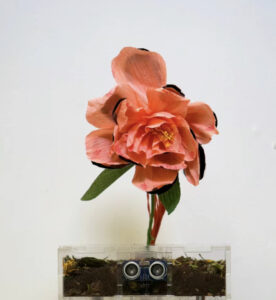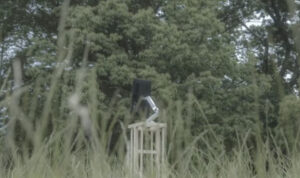Author: Jiayi Sun
Brochure Design
I used Adobe Illustrator to create manuals for the five parts of the entire project. Finally print it out. It is convenient for experiencers to better understand the entire process.
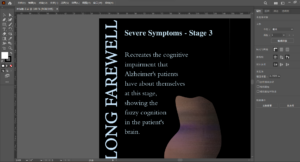
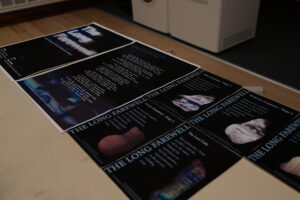
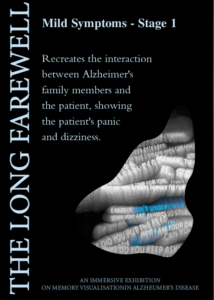
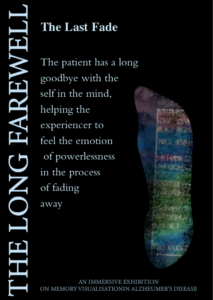

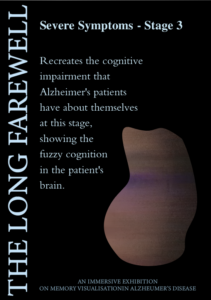

Part 2-AI-generated sounds for poetry
I used AI software to create simulated human voices. The background sound of the poem we wrote in the second part was produced using AI.
This is process in AI Voice Generate
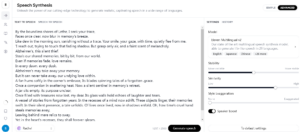
This is AI voice
Final presentation video
We recorded a lot of videos during production and on the day of the final presentation. We organized the footage and edited it into the video below to better demonstrate our final success.
I use Adobe AE, Ar and some editing software to synthesize the video.
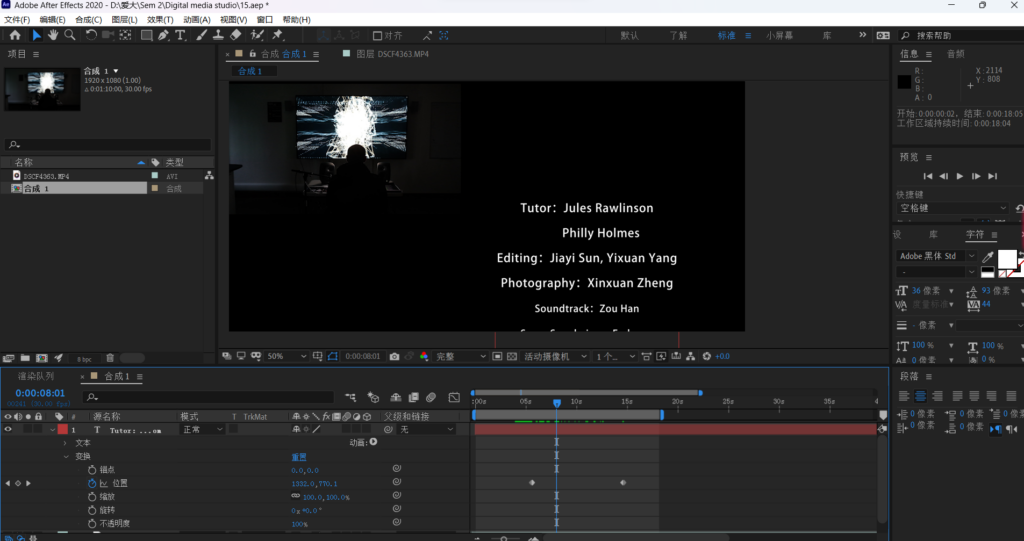

This is the video link:https://media.ed.ac.uk/media/The+long+farewell/1_2h5zctr4
Week8 Part 1-Animation rhythm adjustment and special effects
What I completed this week is:
1.Part One: An attempt to add multiple languages to the text dialogue
2.Part One Animation Rhythm Adjustment
3.Animation editing, synthesis and special effects
1.Part One: An attempt to add multiple languages to the text dialogue
The texts we used in the first part were all English dialogues, but I wanted to try adding other national languages, and after trying it, I found that the effect was pretty good. Later, combined with the sound generated by AI, it can create a more chaotic effect for the experiencer.
1. 妈,你能自己回房间待一会吗 ( Chinese)
2.Maman, tu peux aller seule dans ta chambre pendant un moment ?(French )
3.何度も言いましたから、何度も聞かないでください(Janpanese)
4.Realmente no puedo entender por qué siempre eres tan terco.(spanish)
5.आपका ऐसा करना वाकई बेवकूफी है (India)
6.Папа, это действительно глупо с твоей стороны.(Russia)
7.당신은 나에게 이것을 여러 번 말했습니다 (Korean)
8.Das hast du mir schon oft gesagt (German)
The following is the effect of putting various languages into the animation
I adjusted the overall rhythm of the animation part
The first part is a sentence that slowly flies out.
后面慢慢加速,文字堆满整个屏幕。我用adobe after effect增加了一些抖动,模糊等特效
The final complete effect (no sound version added)
Makeing process:
Week 7 Part 1-AI generated sound and AE animation production
Part 1:
This week I completed the production of the first part of the video where the AI imitates family members’ daily conversations.
The first part of the text: Based on previous literature research and video review, combined with the suggestions given by AI, I wrote 13 sentences about the daily dialogue between family members and Alzheimer’s patients.
- Why do you keep asking the same questions? I’ve explained it many times
- Mom, your memory is really getting worse.
- Where did you put the key? This is already the third time
- Can you stay by yourself for a while
- I am your daughter
- Why don’t you remember me again?
- Dad, why did you put the medicine in the refrigerator again?
- Didn’t we make an agreement?
- I really can’t understand why you are always so stubborn
- I’ve told you many times
- I really don’t have time to help you find things every day
- Why you can’t do simple things well?
- Why do you always forget to turn off the lights? I have to come here every time.
I tried four different ways to get AI to generate speech, and finally I chose to use Elevenlabs AI. There are various timbres, and the generated sounds are real after all. They are emotional sounds, not robot sounds.
Below are all the generated AI sounds.
I made the first part of the video using Adobe After Effects
I will make detailed adjustments next week, and then match the audio with the animation and put them together.
Week6 Part 1- Further research and understanding of Alzheimer’s disease
The first part has been changed. It was originally an animation generated by AI, telling the daily life of an old woman suffering from Alzheimer’s disease. Now, users experience the daily life of Alzheimer’s disease from a first-person perspective. On the big black screen (See picture below), some sentences about the daily life of Alzheimer’s patients floated from all directions (such as: Mom, do you close the door? You don’t recognize me? Dad, where did you put your hat? etc.) . All these words fill the screen and are accompanied by voices speaking in the ears, making the experiencer feel helpless and helpless when suffering from Alzheimer’s disease.

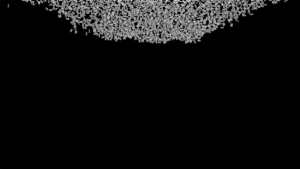
Then I did some literature reading and online video explanations about Alzheimer’s disease this week. I wanted to understand the patient’s daily status to complete the first part of the content.
1.The classic clinical features of Alzheimer’s disease are an amnesic type of memory impairment,8,9 deterioration of language,10 and visuospatial deficits.11,12 Motor and sensory abnormalities, gait disturbances, and seizures are uncommon until the late phases of the disease.6 (Cummings,2004)
2.We found that DAT patients produced significantly more turns and topic shifts but produced fewer total words, words per turn, unique words, narratives, direct quotes, and figures of speech than did their healthy spouses. Examination of DAT speech samples showed that they were characterized both by a lack of propositional content and illocutionary force, illustrating deterioration in communicative competence. (Blonder et al, 1994)
3.Previous research by Boss (1977) indicates that a family may exclude a member in order to reduce the boundary ambiguity.
4.In the case of an ambiguous loss such as that found in Alzheimer’s disease, the family’s task is to clarify the family boundary by redefining family tasks and roles (Boss, 1977).
Reference list:
1.Cummings, J. L. (2004). Alzheimer’s disease. New England journal of medicine, 351(1), 56-67.
2.Blonder, L. X., Kort, E. D., & Schmitt, F. A. (1994). Conversational discourse in patients with Alzheimer’s disease. Journal of Linguistic Anthropology, 4(1), 50-71.
3.Boss, P., (1987). Family stress: Perception and context (pp. 695–723). In N. Sussman & S. Steinmetz (eds.), Handbook on marriage and the family. New York : Plenum Press.
I searched a lot of videos on the Internet to learn more about the daily lives of patients and their families.

 https://vm.tiktok.com/ZGeUsGNcc/ https://vm.tiktok.com/ZGeUstXKG/
https://vm.tiktok.com/ZGeUsGNcc/ https://vm.tiktok.com/ZGeUstXKG/
Week6 Book space and screen, device experience sketch _Jiayi Sun
The experiencer enters the room and stands in front of the screen.

As shown in this image
This is the room we plan to book (ECA main building, E15A)

And this is screen.
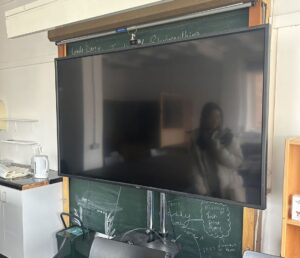
Week2_Wake-up-flower-installation_JiayiSun
Wake up flower installation.
Project introduction: Some withered and dying flowers in daily life are awakened with some simple actions through an interactive device. For example, add a drop of water, touch gently, etc. to wake up the flowers. When the flowers are awakened, they will make a sound (such as a melody, a sentence, etc.).
Project inspiration: How many bouquets of flowers have you ever bought? Did you end up throwing them away? In fact, people and flowers are very similar. Flowers will bloom and wither, and so will people. Everything in the world is like this, from new to old, from young to old. I want to express that everyone should better accept the withering of flowers and thus the aging of people.
Installation design: withered flower model (can be made by hand, adding some spots or rough cracks, etc., as shown in the picture below). After waking up the flower, you can add lights, change the movement of the flower, etc., so that the flower model can be reborn. It is also equipped with speakers to produce sound. The final display can be displayed outdoors to better integrate with nature, as shown below.
